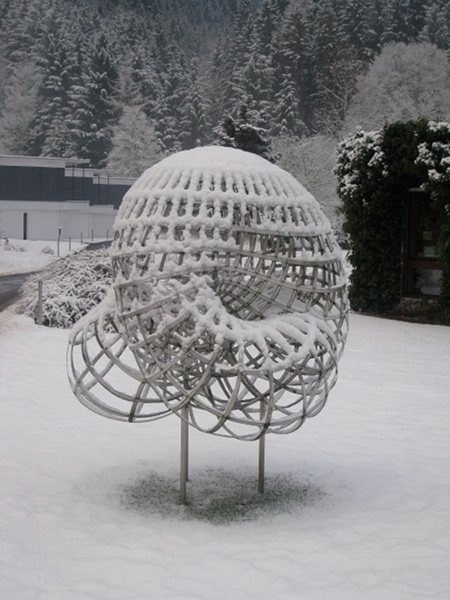So, beyond mathematicians' categorizing all the finite simple groups and enumerating all the ways you can get the rest of the finite groups out there by gluing smaller groups together, it turns out that that we have fairly good algorithms for enumerating all the groups of a given order, and of all the groups whose order is less than 2000, most of them have order 1024.
As this MathOverflow post and this blogpost point out, this sort of behavior may quite likely to be a general phenomenon.
Old news, but it's pretty damn neat.
Thursday, December 6, 2012
Sunday, November 18, 2012
Robert Ghrist!
This is what turned me on to higher math. I had no idea these lectures were floating around the internet until today. Enjoy them!
Monday, October 8, 2012
Let's do some basic math problems!
On the strikeout: math is fun, and being handed problems you know how to solve is also fun. How long has it been since you did long division in your head? This isn't teaching me anything new, but it makes my mind feel more limber.
Wednesday, September 12, 2012
ABC Conjecture
Heard the news? It's a big deal if the proof goes through.
Shinichi Mochizuki recently released a 500-page proof (split up in four sections) that claims to have solved the ABC conjecture:
Apparently he needed to use non-well-founded sets to get this result. Neat stuff.
Paper 1 Paper 2 Paper 3 Paper 4
Updated to add better-educated folks' commentary on the paper:
Take one Take Two Take Three MathOverflow
Shinichi Mochizuki recently released a 500-page proof (split up in four sections) that claims to have solved the ABC conjecture:
$\, \forall \, \epsilon > 1 \, \exists \,$ only finitely many coprime $a, b$ such that $d^{\epsilon} < c$ where $c=a+b$ and $d$ is the product of the unique prime factors of $abc$ (the "square free" part).
Paper 1 Paper 2 Paper 3 Paper 4
Updated to add better-educated folks' commentary on the paper:
Take one Take Two Take Three MathOverflow
Wednesday, August 15, 2012
Real Analysis $\mathbb{R}$e-view
On going through a layperson-readable take on Skolem's paradox here I noticed that the author (Steven Landsburg) talked about producing different models of $\mathbb{R}$ from different 'models' of $\mathcal{P}(\mathbb{Q})$ (powersets of the rationals). Why didn't he talk about Cauchy sequences? (because that's how we construct $\mathbb{R}$, right?)
As long as we don't mind throwing out the really boring sequences (like $\{1,1,1,1...\}$) with only finitely many unique elements, no emphasis on sequences is necessary. Because $\mathbb{Q}$ is countable, any subset is at most countable, and can be ordered and considered as a sequence. Furthermore, actually assigning an ordering is unnecessary...
Call a subset $S \subset \mathbb{Q}$ a Cauchy subset iif
1) $S$ is infinite
2) $\, \forall \, \epsilon > 0 \, \exists \, x \in S$ such that $\{ y \in S : |x-y|\geq \epsilon \}$ is finite
As an exercise, show (because my probably-nonexistent readership loves exercises, right?)
-$S$ is a Cauchy sequence under a particular ordering $\Leftrightarrow$ $S$ is a Cauchy set $\Leftrightarrow$ $S$ is a Cauchy sequence under every ordering.
-All the above statements/definitions work equally well with subsets of $\mathbb{R}$, not just $\mathbb{Q}$. (hint: show that condition 2 forces $S$ to be at most countable)
As long as we don't mind throwing out the really boring sequences (like $\{1,1,1,1...\}$) with only finitely many unique elements, no emphasis on sequences is necessary. Because $\mathbb{Q}$ is countable, any subset is at most countable, and can be ordered and considered as a sequence. Furthermore, actually assigning an ordering is unnecessary...
Call a subset $S \subset \mathbb{Q}$ a Cauchy subset iif
1) $S$ is infinite
2) $\, \forall \, \epsilon > 0 \, \exists \, x \in S$ such that $\{ y \in S : |x-y|\geq \epsilon \}$ is finite
As an exercise, show (because my probably-nonexistent readership loves exercises, right?)
-$S$ is a Cauchy sequence under a particular ordering $\Leftrightarrow$ $S$ is a Cauchy set $\Leftrightarrow$ $S$ is a Cauchy sequence under every ordering.
-All the above statements/definitions work equally well with subsets of $\mathbb{R}$, not just $\mathbb{Q}$. (hint: show that condition 2 forces $S$ to be at most countable)
Sunday, May 13, 2012
(AG) Reading Rainbow: Get Your Books!
So there's an Algebraic Geometry reading group at this subreddit.
If you're up for this, it looks like you'll have to buy the Beltrametti et al book on your own. But if you're looking to pick up the other books, and maybe you also want to score an Introduction to Commutative Algebra with some solution manuals on the side... I know a guy... (the blogger gestures down a nearby alley)
Follow the link after the break...
If you're up for this, it looks like you'll have to buy the Beltrametti et al book on your own. But if you're looking to pick up the other books, and maybe you also want to score an Introduction to Commutative Algebra with some solution manuals on the side... I know a guy... (the blogger gestures down a nearby alley)
Follow the link after the break...
Sunday, April 29, 2012
Provability < Proof
I haven't touched this blog in over a month.... time to post more!
While I'm fooling around with other stuff, enjoy something I learned in freenode's #math channel a few minutes ago (after the break, with names omitted)
While I'm fooling around with other stuff, enjoy something I learned in freenode's #math channel a few minutes ago (after the break, with names omitted)
Yet another reason to find Gödel's incompleteness theorems surprising
Thursday, March 15, 2012
Keepin' it Hyperreal
I haven't posted anything here in a while, so let's do something cool... like construct $^*\mathbb{R}$
Swag.
This will be more about the crazy set theory shenanigans that go into building $^*\mathbb{R}$, rather than actually working in $^*\mathbb{R}$... maybe I'll cover the practical side in another blogpost...
Monday, February 27, 2012
Torsion in the Twists (Belt/Plate Trick)
This is a follow-up post to the statement at the end of Everyday I'm $\mathbb{RP}^{n+1}$, that $\pi_1\left(\mathbb{RP}^3\right) \cong \mathbb{Z}_2$
$\mathbb{Z}_2$... Isn't that the finite simple group of order two?
It was only a matter of time before I found an excuse to post this...
Anyway, have some links:
A quick video of the corresponding plate trick*
Brief discussions here and here of the belt/plate trick, courtesy Wikipedia.Some nice demonstrations (and also discussions) of the tricks, courtesy Bob Palais.
A quick video of the much-related quaternion handshake**
*In the plate trick, a path in $SO(3)$ corresponding to a $720^\circ$ rotation is traced out over time by your hand, and the homotopy to a $0^\circ$ rotation is traced out 'spatially' as you move up/down your arm. These roles are reversed in the belt trick, where the path is traced out spatially and the homotopy occurs over time.
**$\mathbb{RP}^3$ is a quotient of $S^3 \subset \mathbb{R}^4$. The quaternions are isomorphic to $\mathbb{R}^4$ as an $\mathbb{R}$-vector space.
So it shouldn't be too surprising that $SO(3)$ is a quotient of the unit quaternions.
Thursday, February 23, 2012
$SO(3)$ What
So I dumped it here instead. I'll probably re-tool that entire post in the coming week...
Monday, February 20, 2012
Everyday I'm $\mathbb{RP}^{n+1}$
When I was just a little boy and my dad was tucking me into bed one night, we (somehow) got to talking about the overall shape of the universe. It just sort of goes on forever... doesn't it? According to my old man, there were some people who thought that space didn't exactly go on forever. "When you travel far enough in that direction," he said, pointing to one corner of the room, "you eventually come back to the place you started, but you'll approach it from there," he said as he pointed to the opposite corner.
At the time, I had imagined that he was describing something like a 3-torus, i.e. $S^1 \times S^1 \times S^1$. Nowadays, I'm certain he was talking about $\mathbb{RP}^3$ instead.
Hrm... I should ask him about this stuff the next time I see him...
At the time, I had imagined that he was describing something like a 3-torus, i.e. $S^1 \times S^1 \times S^1$. Nowadays, I'm certain he was talking about $\mathbb{RP}^3$ instead.
Hrm... I should ask him about this stuff the next time I see him...
Pinkie Pie's parents must have taught her how to appreciate abstract notions of space as well.
Today we'll construct $\mathbb{RP}^3$ and see why it's homeomorphic to $SO(3)$, a subset of $O(3)$.
Don't fret if you don't know what it means for two spaces to be 'homeomorphic'. We're just going to visualize each one and convince ourselves that they're both the same shape.
Sunday, February 12, 2012
Everyday I'm $\mathbb{RP}^n$
So Rainbow Dash was like, "Hey Fluttershy, have you been doing exercises with the Zariski Topology recently? 'Cause you've got one affine variety right there."
(Fluttershy's reaction needs no further comment)
Today we'll be building projective spaces! Euclidean Geometry and Algebraic Geometry construct these spaces in different ways, so we'll do them both and look at how we can relate one to the other.
The space that gives us our familiar $n$-dimensional geometries, $\mathbb{R}^n$, is called the affine $n$-space over $\mathbb{R}$. You can also have affine spaces over an arbitrary field $\mathbb{F}$, but... we won't go there today.
The projective $n$-space over a field is the equivalence class of lines through the origin in the affine $n+1$-space over that field. Basically, we get rid of the origin, $\vec{0}$, and 'collapse' together each equivalence class of points in $\mathbb{F}^n \backslash \{\vec{0}\}$ under the equivalence relation $\vec{a_1} \sim \vec{a_2}$ iff $\vec{a_1} = \lambda \vec{a_2}$ for some $\lambda \in \mathbb{F}$. That's a bit abstract, so let's try to make this more intuitive. Let's just try to construct $\mathbb{RP}^2$ out of $\mathbb{R}^3$ for now.
Let's do some judicious collapsing: Instead of collapsing the entire equivalence class of $\vec{a}$ to a single point, let's just map each $\vec{a} \in \mathbb{R}^3$ to the point on unit sphere, $S^2$, corresponding to $\frac{\vec{a}}{||\vec{a}||}$
Note that the point we sent $\vec{a}$ to, $\frac{\vec{a}}{||\vec{a}||}$, is genuinely in the same equivalence class as $\vec{a}$ (as $\frac{1}{||\vec{a}||} \in \mathbb{R}$).
Note that I've only 'partially collapsed' $\mathbb{R}^3 \backslash \{\vec{0}\}$; each pair of antipodes (opposite poles) $a, b \in S^2$ are in the same equivalence class by $a = -b$.
So if the sun is the origin in $\mathbb{R}^3$, all ponies on the line connecting the sun to Rarity (excluding any ponies hiding in the center of the sun, but including any ponies hiding on the other half of the line, behind the sun) are mapped to the same point of $\mathbb{RP}^2$
Since we're going to collapse one half of the sphere directly into the other, let's only worry about one half of the sphere for now (without worrying about what's going to happen to the equator). Let it be the half resting above the $xy$ plane, i.e. all $(x,y,z) \in S^2$ such that $z > 0$. "Project" the surface of the sphere (via the lines through the origin) onto the plane $z=1$, i.e. map each $(x,y,z)$ in this half of $S^2$ to $(\frac{x}{z},\frac{y}{z},1)$. This is a bijection between $\mathbb{R}^2$, i.e. the plane defined by $z=1$, and the open upper half of $S^2$. So $\mathbb{RP}^2$ is just like $\mathbb{R}^2$ if we leave out the stuff related to that equator in the $xy$ plane (note that these are the only equivalence classes of points that aren't defined by our map). Now what's so special about this equator? Time for a detour...
The way the projective plane is built from Euclid's axioms is that we take our affine plane, and for each equivalence class of parallell lines, we add a corresponding 'point at infinity'.
Note that in order for parallell lines to truly form equivalence classes, we have to let every line $l_1$ be parallell to itself (maybe 'lines that have the same slope' is the better term).
So these 'points at infinity' are sort of like a spot on the horizon. They're infinitely far away, but they occupy well-defined angles from the origin. Technically speaking though, it's a pair of angles from the origin: the point where the lines $x=1$ and $x=2$ is both 'infinitely far up' and 'infinitely far down.'
Projective space sort of wraps around on itself. Additionally, the collection of points at infinity also form a 'line at infinity,' but how they happen to form a line might not be obvious until we look back at our other construction...
This 'line at infinity' is precisely the equator of $S^2$ in the $xy$ plane that we couldn't map into the plane of $z=1$. And the 'point at infinity' that corresponds to the class of lines with slope $m$ will correspond to the points $\left( \frac{m}{\sqrt{m^2+1}},\frac{1}{\sqrt{m^2+1}},0 \right)$ and $\left( \frac{-m}{\sqrt{m^2+1}},\frac{-1}{\sqrt{m^2+1}},0\right)$ in the $xy$ plane.
It's a nice way of relating one model to another, but it still doesn't give you a visual understanding of what $\mathbb{RP}^2$ should look like once you actually collapse that equator together. The "shape" you'll end up with is what you'd get if you took a unit disc, and stitched its boundary circle to the boundary circle of a möbius band. In order to do that, your disc has to twist around and through itself. Again, regular surfaces in $3$-space are not allowed to do this. As I might have been hinting before, $\mathbb{RP}^2$, like the Klein bottle, can't be embedded in $\mathbb{R}^3$. They can do immersions into $\mathbb{R}^3$, but not embeddings.
That's all for now. The next installment of $\mathbb{RP}^n$-related stuff will probably be about doing all that conic section tomfoolery in $\mathbb{RP}^2$. And maybe why $SO(3) \cong \mathbb{RP}^3$
Wednesday, February 8, 2012
Thoughts $O(n)$ Matrices
My sister recently came home from visiting her boyfriend's family in India, and she brought back some of the best tea Hyderabad had to offer. Needless to say, I approve of their courtship.
Best Assam ever. Image stolen from here
While I work on more fancy math shenanigans, let's look at my favorite groups of matrices, the orthogonal and unitary groups.Tuesday, February 7, 2012
Monday, February 6, 2012
Suspicious... Ugh
I can't get my hooves on (or my head around) a nice proof of Schur Orthogonality. I still don't know how to fill in the gaps left in the proof in Serre's book, and all the online proofs I've found involve taking a straight shot of category theory.
I know, right?
I don't think I have any readers to disappoint right now, but for the people who somehow stumbled in here and are following this business... I'm taking a break from this character theory stuff. I really ought to learn all the math in these lecture-thingies before I start writing them...
I'mma try to learn some stuff about manifolds while I wait for Mac Lane's book on Category Theory to come in the mail...
Wednesday, February 1, 2012
Smale's Paradox
Just stumbled across a nice demonstration of this eversion on youtube:
Part 1 | Part 2
One of the members of Smale's group, Bernard Morin, is notable for being an accomplished topologist in spite of being blind since the age of six. He was also the first person to parametrize Boy's Surface, an immersion of the real projective plane in 3-space. Here's a model of Boy's surface at a mathematical research institute in Oberwolfach, Germany:
Morin, who is still alive, was shown this model one day. Being blind, he had to touch the surface to determine what it was. After a minute or two of feeling around, he shook his head and said, "This is not Boy's Surface. This is a mirror image of Boy's Surface." Morin was, apparently, the first person to point this out.
So with that, think of all the new perspectives you might get if you blindfolded yourself for a month. Vision being a crutch for your spatial imagination and all that.
Story source: the guy who taught me Algebraic Topology.
Part 1 | Part 2
One of the members of Smale's group, Bernard Morin, is notable for being an accomplished topologist in spite of being blind since the age of six. He was also the first person to parametrize Boy's Surface, an immersion of the real projective plane in 3-space. Here's a model of Boy's surface at a mathematical research institute in Oberwolfach, Germany:
Morin, who is still alive, was shown this model one day. Being blind, he had to touch the surface to determine what it was. After a minute or two of feeling around, he shook his head and said, "This is not Boy's Surface. This is a mirror image of Boy's Surface." Morin was, apparently, the first person to point this out.
So with that, think of all the new perspectives you might get if you blindfolded yourself for a month. Vision being a crutch for your spatial imagination and all that.
Story source: the guy who taught me Algebraic Topology.
Sunday, January 29, 2012
Pony Break
Mmk time to break up the monotony. With the Apple family!
Great mixed drink for the winter: Apple Cider and Cinnamon Schnapps (I tend to use Goldschläger). Add to taste.
Don't forget the new episode! (taken down)
Applebloom goes on an 8-bit adventure
Stay thirsty, my ponies.
Great mixed drink for the winter: Apple Cider and Cinnamon Schnapps (I tend to use Goldschläger). Add to taste.
Applebloom goes on an 8-bit adventure
Stay thirsty, my ponies.
Thursday, January 26, 2012
Suspicious Characters, Part 2
It's trace operator time! For those who don't know already, the trace of a matrix is the sum of the entries on the main diagonal.
Why is it importart? We won't be proving this fact today, but the trace of a matrix $\rho_g$ is also the sum of its eigenvalues!
Eigenvalues? Wündebar! Time to make de magics.
Saturday, January 21, 2012
Suspicious Characters, Part 1
For those familiar with linear algebra and group theory...
Suppose we have a group that acts on a vector space. This situation comes up fairly often; every time we have an object situated in euclidean space, the symmetries of the object are a subgroup of the symmetries of the space itself. Even if that seems kind of obvious, this is a genuinely useful insight: the symmetries (a.k.a. automorphisms) of $n$-dimensional euclidean space can be represented by matrices, and there are a lot of powerful techniques out there (e.g. determinants, eigenvalues) that only work on matrices. So studying the matrix representation ought to be a useful technique for understanding the action of the group.
This is more effective than you might realize at first: if both the group and the dimension of our vector space are finite, there is a nice way to decompose the vector space into orthogonal orbit-like-subspaces just by looking at the traces of the matrices. Over the next few blog posts, we'll be investigating this business with decomposition using trace operators--known as character theory.
With some character theory, Rainbow Dash might have noticed
the different subrepresentations of Mare-Do-Well beforehoof.
Friday, January 20, 2012
Discord in the Axioms
You've all heard about Gödel's Second Incompleteness theorem, right? If a theory with a finite list of axioms contains the basis for arithmetic, this theory cannot produce statements about its own consistency without contradicting itself. So we can't ever prove such a theory's consistency; we can only take solace in the notion that we haven't found any contradictions yet. Kind of a bummer.
What It's All About
Everypony knows that the pony pokey is what it's all about. But what about this blog-thingy?
This blog is for sharing the two best things ever: math and ponies. I hope to crank out a pleasant introduction to some interesting math once or twice a week. Pony-related updates will occur as needed. Will I find occasions to combine these two delightful things?
By Celestia's simply-connected flank, I think I should!
Subscribe to:
Posts (Atom)

















